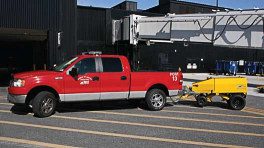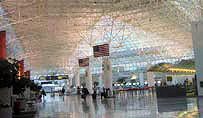 |
FAA Advisory Circular 150/5200-30C, released in December 2008, authorizes two basic types of equipment for conducting friction surveys on runways during winter operations: continuous friction measuring equipment (CFME) and decelerometers. In addition, the FAA made the equipment eligible for federal funding under the Airport Improvement Program, and BWI Marshall opted to acquire state-of-the-art versions of both.
Baltimore-Washington
Decelerometers

The FAA recommends decelerometers for airports such as BWI Marshall, where longer runway downtime required to complete a friction survey is acceptable, and may actually be preferred where it is difficult to gain access to the full length of a runway crossed by another runway.
BWI Marshall historically used mechanical decelerometers, so it heeded the AC’s specific suggestion: “Mechanical decelerometers may be used, but should be reserved as a backup. Airports having only mechanical devices should plan to upgrade as soon as possible.” The AC inspired the airport to shop for new electronic decelerometers to replace its mechanical units, says BWI Marshall airport operations manager Mark Wisbeski.
 |
The equipment it chose – four Dynamic Friction Decelerometers (DFDs) from Neubert Aero Corp. – are touch-screen units designed to comply with FAA regulations exclusively for winter operations. Much like its mechanical predecessor, the DFD measures deceleration, or the forward motion to the braking point, when a vehicle drives down the runway and brakes to lock the wheels. But rather than manually report runway condition readings and braking action reports, the new DFDs automatically compute results from acceleration data. They’re also compatible with the airport’s Panasonic Toughbook laptops and docking stations.
At $1,750 each, Wisbeski says the DFDs are some of the least expensive electronic decelerometers available.
He also considers them to be very “user friendly.” Operating the electronic DFDs is very similar to operating the mechanical version, he says, except you push buttons rather than throw mechanical switches. After calibrating the DFD to make sure it is level and streamlined with the vehicle, the operator drives 20 miles per hour on the runway, applies the brake to come to a complete stop, and a reading is produced to accept or reject. The operator then presses the “next run” prompt to repeat the process.
 “The good thing about the electronic version is that it records all of the information for you,” Wisbeski notes. “You don’t have to manually record as you do with the mechanical version.”
“The good thing about the electronic version is that it records all of the information for you,” Wisbeski notes. “You don’t have to manually record as you do with the mechanical version.”
Wisbeski’s fellow airport operations manager, Shawn Byers, values the paper trail created by all of those readings.
“I like the fact that it is all automatic and you are not writing down your conditions,” Byers says, noting decreased risk of human error. “You are choosing them on a drop-down screen and the computer stores them for you.”
Facts & Figures Project: Airport: Baltimore-Washington International Thurgood Marshall Airport Equipment: 4 Dynamic Friction Decelerometers (DFDs), 1 Dynamic Friction Tester (DFT) Manufacturer: Neubert Aero Corp. Contract Awarded: September 2008 Cost: $7,000 for 4 DFDs, $5,820 to upgrade $42,920 DFT
CFME
In addition to the electronic DFD units, BWI Marshall also acquired continuous friction measuring equipment (CFME) – specifically, a Neubert Aero Corp. Dynamic Friction Tester (DFT) that cost nearly $43,000 – from Martin State, another state-owned airport.
“Martin State has only one runway and they determined they did not need the DFT,” Byers explains. “They asked us if we wanted it and asked for an electronic decelerometer in return.”
BWI Marshall agreed, and then upgraded the newly acquired DFT with an automatic water source and interior wheel up/down controls for $5,820.
Byers appreciates that the new DFT may be used in all weather conditions and, unlike BWI Marshall’s previous CFME, it is compatible with more than 80 of the airport’s maintenance vehicles.
“The nice thing about the DFT is as long as you have a vehicle with a tow hitch, you can mount it. It is not a dedicated vehicle like the minivan is a dedicated friction tester,” he says. Every time the wheel pulls around, data is measured into the system for analysis and results of runway friction and contaminate values.
In addition to providing advanced technology, the DFT was also financially attractive. “The cost is less because you are paying for the individual unit, not the entire vehicle built around it,” Wisbeski explains.
The airport’s previous vehicle-mount CFME was purchased for $117,000 in 1993 – “older technology that may be on the way out,” says Byers.
A Strong Team
Information from both the DFD and DFT units is ultimately transmitted to the Notice to Airmen System (NOTAMS). The data may also be disseminated to Air Traffic Control to provide reference values for braking action conditions to pilots on final descent. Pilots combine those values with specific aircraft performance capabilities to optimize flight conditions for safe landing and take-off.
Working in tandem, BWI Marshall’s DFD and DFT cover a spectrum of needs. The airport can assess and monitor changing surface conditions with the continuous friction measuring device in winter, while the decelerometer can efficiently spot check changing conditions without pulling out the tow-behind device and re-measuring.
Last winter, BWI Marshall encountered four significant weather events that prompted it to use the DFDs and the DFT. According to NAC, it is the first commercial airport to acquire both types of equipment.
“The testing of friction and reporting of Mu no longer needs to be subjective,” says NAC president Tim Neubert. “The measurement of friction is a science and, with proper equipment, airports like BWI should be able to provide accurate, repeatable data in monitoring runway condition assessments and reporting of those assessments.”
Neubert contends that airports should continue reporting the latest braking action for the runway in use to each arriving and departing aircraft for liability reasons even if the FAA no longer requires it.


